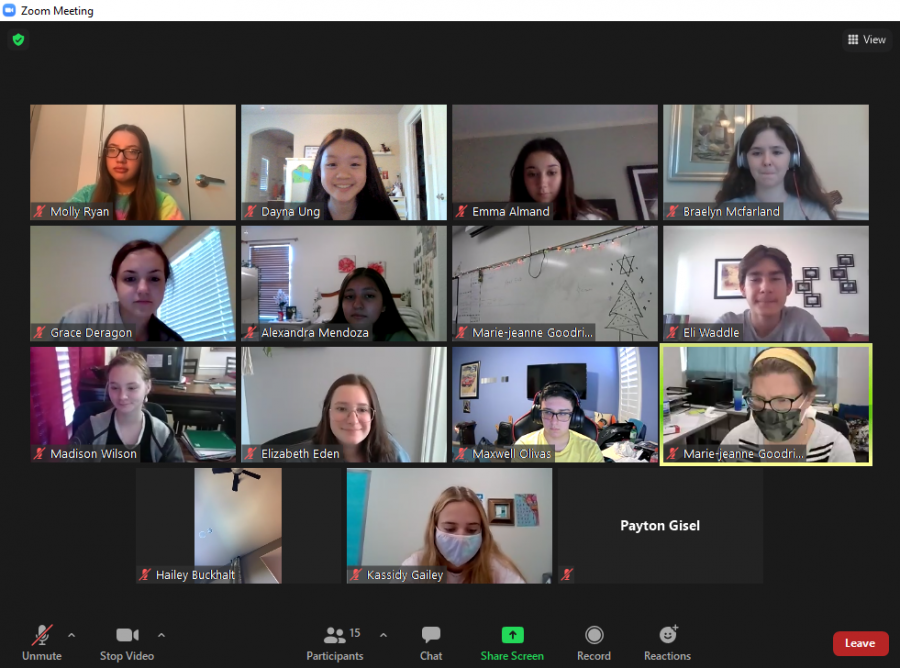Learning a handy language
American sign language students and teacher tackle a new learning environment
Mrs. Goodrich teaches her ASL students during class on both Zoom and in-person.
November 20, 2020
Her teacher’s hands dance across her screen and as they do, she recognizes the signs presented. Then the screen freezes suddenly. She tried to recall the last sign. Was her teacher pointing to her nose or her mouth, was she happy or surprised?
Seniors Braelyn McFarland and Belle Vergara are two American Sign Language IV students trying to navigate learning sign language when so much of the language relies on facial expressions and exact placement of signs on a person’s face. So much of the learning process has been complicated by facemasks.
“It’s a lot harder online because it’s really hard to see her when she’s signing,” Vergara said. “It’s not something you can just talk about. You always have to look at the signer and sign on the camera.”
Vergara described the hardships of taking an online ASL class. She said that having a Deaf teacher makes communication challenging,
“Doing ASL on Zoom can be really difficult,” Vergara said. “Our teacher can’t hear because she is Deaf. So when we want to ask a question, we have to type everything, or we would have to read it. Overall, it was really hard to try to communicate with her over Zoom.”
McFarland elaborated the struggles of Zoom class. She said unlike normal classes with hearing teachers where you can look away or work on other things, watching signs requires your full attention. If she looks away for a few seconds, several sentences could’ve been signed and it would be harder to understand.
“I would definitely say that in person learning is easier than online learning,” McFarland said. “You have to make sure you stay on the screen, and if it glitches, it can make it harder to understand signs. Also, if you accidentally look away from the screen for a second and come back, you could miss an entire conversation. Especially if your house is loud, it’s harder to pay attention during certain moments.”
McFarland said that not only does Zoom make signing difficult, but wearing masks interrupts communication in ASL. McFarland explained NMMs (Non Manual Morphemes) to be facial expressions and how crucial they are to communication.
“It’s harder to see the direct location if someone’s trying to sign on their lip versus their nose,” McFarland said. “A mask makes it a little bit more strenuous to tell. Also, you can’t really see NMMS anymore, the facial expressions.”
While McFarland is online and sees one aspect of things, Vergara goes to school and is able to see the amount of work her teacher, Mrs. Goodrich, has put forward.
“My teacher is doing an amazing job at it,” Vergara said. “She will have her laptop at the front and then all of us behind, so we can all see what she’s signing. I think that’s a really good way of doing it. She also has a screen in her classroom where we can take off our masks and put the screen in front of us and actually see our face. It is useful because if we need to record any video, we can go behind the screen and see our faces. Her methods work very well and are super effective.”
Although both girls said ASL IV can be tough with many challenges, they agreed that there is a strong community within ASL. McFarland said she remembers a fun time during her ASL class where one of the students said she was cold and a bunch of people gave her a jacket, leaving her to sign with five jackets on the entire class.
Vergara agrees with this idea while describing her extra commitment to ASL.
“I do see a lot of community because I’m also in ASL Honor Society,” Vergara said. “We have meetings where we’ll go meet Deaf people in the community. I think it’s nice to be able to see them and see all these new people. And they honestly help us a lot with trying to figure out learning the language.”
McFarland encourages students new to ASL to practice often to help become fluent.
“I feel like my biggest advice would be either try to find a friend you have in the class or someone you know who’s taken the class before to sign with them outside of class, work on your skills, or try to look for signing videos that interests you,” McFarland said. “Even if you watch a clip of someone signing a music video and you don’t understand it, you’re engaging and trying to introduce yourself to signs which makes it a lot easier.”
ASL teacher, Mrs. Goodrich, said she enjoys teaching her students about ASL because she wants to be a part of bridging the two worlds together. Mrs. Goodrich grew up speaking French and English and said her mom always called her the “bridge girl” as she connected French, English, hearing, and Deaf communities. As much as Mrs. Goodrich loves to educate others about ASL, teaching ASL has proved to be a difficult challenge.
“This year, quality access to the daily lesson, being able to see students well in a tiny square, and engagement have all been major struggles,” Mrs. Goodrich said. “The level of engagement is much lower due to our system, and students are so tired of being on the camera that I think to do more video recording is just so much that students have had it with this kind of learning. For me, the load has tripled and teaching live on Zoom is a struggle especially with connection issues.”
However, Mrs. Goodrich has found a positive end to this consuming obstacle through programs like ASL Deafined, which is an online tool that can be used to help students learn ASL, Youtube videos that help solidify the material, and future plans for more reinforcement of signs.
“This problem has led to teachers to start thinking outside of the box and learn how to use different materials and different ways to teach ASL,” Mrs. Goodrich said. “This is forcing teachers to look at teaching from a more creative perspective. In the future, I plan on doing small groups so students can have a more personalized education, and I want to find ways to play games such as bingo that will help students engage more.”
Overall, McFarland and Vergara said they are passionate about ASL and would encourage other students to take the class. Vergara said she loved the language because of its expressive nature and the emotions you have to put into it, and she finds it to be a fun and interesting language to learn.
“I would definitely recommend ASL because I feel that, unlike all the other languages here, it’s really interesting to learn,” Vergara said. “It is very different from anything you’ve seen. You don’t talk, you sign and use expressions with your face. I know it’s hard with everything that’s going on, but just keep trying. I know it may not seem easy right now, but I promise you it is. All you have to do is just listen and learn.”








